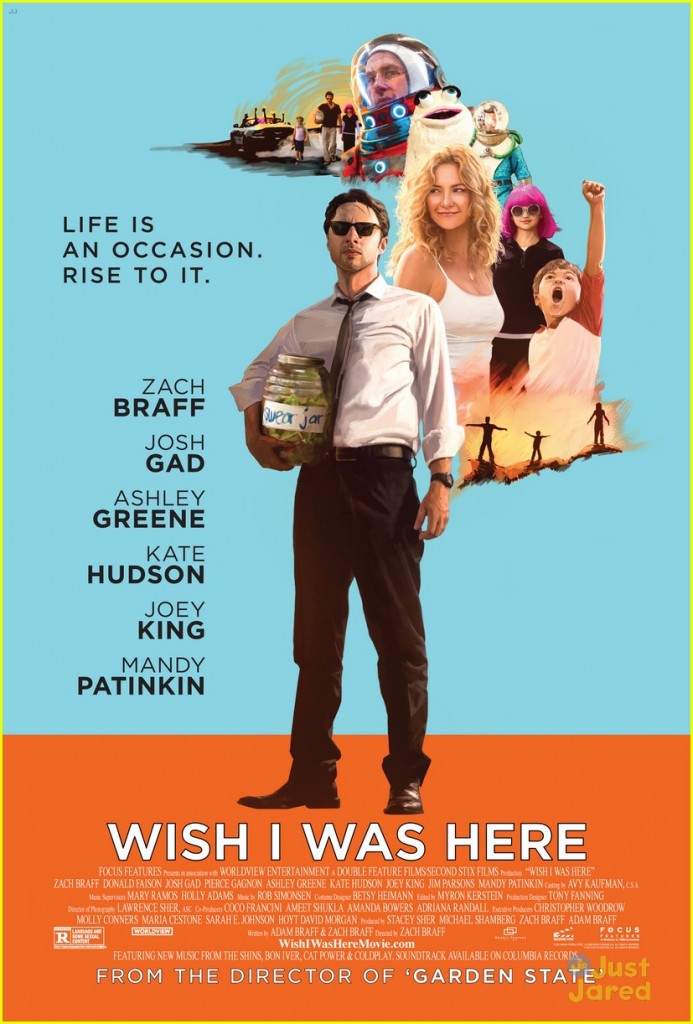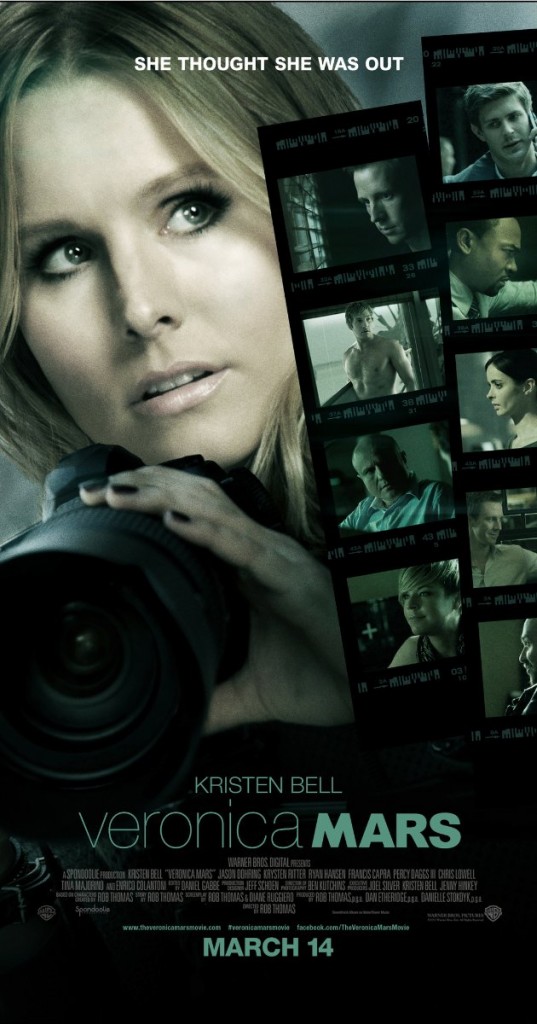Crowd Funded Cinema: The Future of Film
With the impending release of
Wish I Was Here (
Our Review) this Friday (7/18), Entertainment Fuse has decided to take a look at how crowd funding has impacted the world of cinema.

Zach Braff's debut film was the cult hit,
Garden State (2004), and ever since, fans have been teeming for a follow-up. Braff complained that the studio system was a hinderance to his vision, and that he would rather crowd find the project to retain creative control. He posted the film to Kickstarter, and within three days, it had met and exceeded its original $2 million goal. While this is certainly not the first film made via crowd funding, it certainly garnered plenty of attention through social-media websites like reddit and Twitter. Crowd funding has opened the door for young or inexperienced filmmakers to produce their vision. The upside to which is the release of new and original films devoid of the increasingly-stale Hollywood flavor, and the downside to which, being the influx of a lot of pointless and poorly-made films.

One of the first major films to be produced via crowd funding was
Veronica Mars, a much awaited film based on the television show of the same name.
Veronica Mars was a beloved television series featuring a young Kristen Bell as a high school private detective who investigates crimes in her hometown of Neptune, CA. The series developed a wide array of followers, even after the show's cancellation, who had their hearts set on a movie. Six years after the final season of
Veronica Mars, series creator, Rob Thomas – and various members of the crew – were featured in a video on the film's Kickstarter page asking fans for money to produce the project. They hit the goal of $2 million in under ten hours. As the fastest project to reach the one and two million dollar goal,
Veronica Mars was the biggest Kickstarter project in history. When the film opened earlier this year to positive reviews and box-office numbers of $3,458,127, it forced Hollywood to take crowd funding seriously.
 Veronica Mars
Veronica Mars proves to be an interesting case, because it opened the door for other highly-regarded television shows (and even YouTube series) to be made into movies. The popular Spike TV hit comedy,
Blue Mountain State, started a Kickstarter for its full length feature, and reached its $1.5 million goal in under a month. When
Community was cancelled by NBC, there was a massive outcry by fans, some of which wanted series creator, Dan Harmon, to do a crowd-funded sixth season – AND a full length feature (remnants of the “Six seasons and a movie” battle-cry adopted by fans). Yahoo! Ended up picking up the series for another season, but the opportunity for a movie is still pending (and perhaps in development according the the
HollywoodReporter.com). Extrapolating into the future, there might be a boon in the development of crowd-funded movies that would compete with the VOD corporations (who are currently gobbling-up any and all television rights). Hell, we might finally get that
Arrested Development movie we have been waiting eight years for.

Even big-name directors are getting into the crowd funding game. Spike Lee began his Kickstarter for his “Newest Hottest Joint”,
Da Sweet Blood of Jesus, in August of 2013, and closed funding after reaching its $1.25 million goal in under 30 days. His film is said to be a remake of Bill Gunn's seminal 1973 independent film,
Ganja and Hess, and began touring the festival circuit in June. Lee's production of a pet-project film via crowd funding, has paved the way for other powerful and influential directors to make movies that they cannot get produced traditionally. With websites like Kickstarter and Indiegogo, directors can forgo the route Hitchcock took with
Psycho, and get their fans to fund the projects for them.

Crowd funding cinema is certainly a very democratic process, but it is not perfect. Most major motion pictures require an enormous budget that would still need contributions from studios. There is also the issue of mass distribution, wherein getting a small, independently-funded film into cinemas, where the supporters can actually watch it, is still in the hands of corporations. Nevertheless, the growing capability of VOD/streaming services and the proliferation of high-quality digital filming equipment, coupled with the power of crowd funding, makes the future a very exciting place for film.
 Zach Braff's debut film was the cult hit, Garden State (2004), and ever since, fans have been teeming for a follow-up. Braff complained that the studio system was a hinderance to his vision, and that he would rather crowd find the project to retain creative control. He posted the film to Kickstarter, and within three days, it had met and exceeded its original $2 million goal. While this is certainly not the first film made via crowd funding, it certainly garnered plenty of attention through social-media websites like reddit and Twitter. Crowd funding has opened the door for young or inexperienced filmmakers to produce their vision. The upside to which is the release of new and original films devoid of the increasingly-stale Hollywood flavor, and the downside to which, being the influx of a lot of pointless and poorly-made films.
Zach Braff's debut film was the cult hit, Garden State (2004), and ever since, fans have been teeming for a follow-up. Braff complained that the studio system was a hinderance to his vision, and that he would rather crowd find the project to retain creative control. He posted the film to Kickstarter, and within three days, it had met and exceeded its original $2 million goal. While this is certainly not the first film made via crowd funding, it certainly garnered plenty of attention through social-media websites like reddit and Twitter. Crowd funding has opened the door for young or inexperienced filmmakers to produce their vision. The upside to which is the release of new and original films devoid of the increasingly-stale Hollywood flavor, and the downside to which, being the influx of a lot of pointless and poorly-made films.
 One of the first major films to be produced via crowd funding was Veronica Mars, a much awaited film based on the television show of the same name. Veronica Mars was a beloved television series featuring a young Kristen Bell as a high school private detective who investigates crimes in her hometown of Neptune, CA. The series developed a wide array of followers, even after the show's cancellation, who had their hearts set on a movie. Six years after the final season of Veronica Mars, series creator, Rob Thomas – and various members of the crew – were featured in a video on the film's Kickstarter page asking fans for money to produce the project. They hit the goal of $2 million in under ten hours. As the fastest project to reach the one and two million dollar goal, Veronica Mars was the biggest Kickstarter project in history. When the film opened earlier this year to positive reviews and box-office numbers of $3,458,127, it forced Hollywood to take crowd funding seriously.
One of the first major films to be produced via crowd funding was Veronica Mars, a much awaited film based on the television show of the same name. Veronica Mars was a beloved television series featuring a young Kristen Bell as a high school private detective who investigates crimes in her hometown of Neptune, CA. The series developed a wide array of followers, even after the show's cancellation, who had their hearts set on a movie. Six years after the final season of Veronica Mars, series creator, Rob Thomas – and various members of the crew – were featured in a video on the film's Kickstarter page asking fans for money to produce the project. They hit the goal of $2 million in under ten hours. As the fastest project to reach the one and two million dollar goal, Veronica Mars was the biggest Kickstarter project in history. When the film opened earlier this year to positive reviews and box-office numbers of $3,458,127, it forced Hollywood to take crowd funding seriously.
 Veronica Mars proves to be an interesting case, because it opened the door for other highly-regarded television shows (and even YouTube series) to be made into movies. The popular Spike TV hit comedy, Blue Mountain State, started a Kickstarter for its full length feature, and reached its $1.5 million goal in under a month. When Community was cancelled by NBC, there was a massive outcry by fans, some of which wanted series creator, Dan Harmon, to do a crowd-funded sixth season – AND a full length feature (remnants of the “Six seasons and a movie” battle-cry adopted by fans). Yahoo! Ended up picking up the series for another season, but the opportunity for a movie is still pending (and perhaps in development according the the HollywoodReporter.com). Extrapolating into the future, there might be a boon in the development of crowd-funded movies that would compete with the VOD corporations (who are currently gobbling-up any and all television rights). Hell, we might finally get that Arrested Development movie we have been waiting eight years for.
Veronica Mars proves to be an interesting case, because it opened the door for other highly-regarded television shows (and even YouTube series) to be made into movies. The popular Spike TV hit comedy, Blue Mountain State, started a Kickstarter for its full length feature, and reached its $1.5 million goal in under a month. When Community was cancelled by NBC, there was a massive outcry by fans, some of which wanted series creator, Dan Harmon, to do a crowd-funded sixth season – AND a full length feature (remnants of the “Six seasons and a movie” battle-cry adopted by fans). Yahoo! Ended up picking up the series for another season, but the opportunity for a movie is still pending (and perhaps in development according the the HollywoodReporter.com). Extrapolating into the future, there might be a boon in the development of crowd-funded movies that would compete with the VOD corporations (who are currently gobbling-up any and all television rights). Hell, we might finally get that Arrested Development movie we have been waiting eight years for.
 Even big-name directors are getting into the crowd funding game. Spike Lee began his Kickstarter for his “Newest Hottest Joint”, Da Sweet Blood of Jesus, in August of 2013, and closed funding after reaching its $1.25 million goal in under 30 days. His film is said to be a remake of Bill Gunn's seminal 1973 independent film, Ganja and Hess, and began touring the festival circuit in June. Lee's production of a pet-project film via crowd funding, has paved the way for other powerful and influential directors to make movies that they cannot get produced traditionally. With websites like Kickstarter and Indiegogo, directors can forgo the route Hitchcock took with Psycho, and get their fans to fund the projects for them.
Even big-name directors are getting into the crowd funding game. Spike Lee began his Kickstarter for his “Newest Hottest Joint”, Da Sweet Blood of Jesus, in August of 2013, and closed funding after reaching its $1.25 million goal in under 30 days. His film is said to be a remake of Bill Gunn's seminal 1973 independent film, Ganja and Hess, and began touring the festival circuit in June. Lee's production of a pet-project film via crowd funding, has paved the way for other powerful and influential directors to make movies that they cannot get produced traditionally. With websites like Kickstarter and Indiegogo, directors can forgo the route Hitchcock took with Psycho, and get their fans to fund the projects for them.
 Crowd funding cinema is certainly a very democratic process, but it is not perfect. Most major motion pictures require an enormous budget that would still need contributions from studios. There is also the issue of mass distribution, wherein getting a small, independently-funded film into cinemas, where the supporters can actually watch it, is still in the hands of corporations. Nevertheless, the growing capability of VOD/streaming services and the proliferation of high-quality digital filming equipment, coupled with the power of crowd funding, makes the future a very exciting place for film.
Crowd funding cinema is certainly a very democratic process, but it is not perfect. Most major motion pictures require an enormous budget that would still need contributions from studios. There is also the issue of mass distribution, wherein getting a small, independently-funded film into cinemas, where the supporters can actually watch it, is still in the hands of corporations. Nevertheless, the growing capability of VOD/streaming services and the proliferation of high-quality digital filming equipment, coupled with the power of crowd funding, makes the future a very exciting place for film.